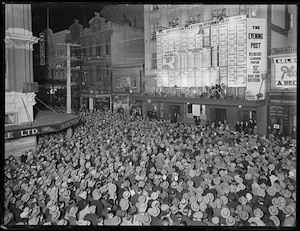 Last summer while I was in Boston on a trip with my family, we decided to take a boat tour of Boston Harbour. I didn’t get much from the experience. Granted, the operators did their very best to provide everyone on-board with a safe, informative tour, but the boat was awfully crowded and it didn’t take long before there was a palpable sense on the faces of most around me of “how soon will this thing be over?”
Last summer while I was in Boston on a trip with my family, we decided to take a boat tour of Boston Harbour. I didn’t get much from the experience. Granted, the operators did their very best to provide everyone on-board with a safe, informative tour, but the boat was awfully crowded and it didn’t take long before there was a palpable sense on the faces of most around me of “how soon will this thing be over?”
In contrast, a few days earlier we joined a small group and did a guided walking-tour of a coastal New England town that had a rich history and a great story to tell. Not only was the tour a lot of fun, we had the opportunity to get to know some of the others in that small group, such that by the end of the tour most were acquainted on a first-name basis.
Following large crowds are fine for certain things. They’re an inevitable part of professional sports and music, for instance. But the dynamic there is one on which you’ve all gathered to see a spectacle, getting to know the people around you is secondary. Networking, on the other hand, is more like a series of smaller groups. Each cluster has its own conversation, and each one works best when everyone is as engaged as a listener as they are as a speaker.
Too often, social media tends to be treated like a mass spectacle. For many, it’s tempting to assume that the end-game is about seeing how many follows they can get. They’ll engage auto-follow on twitter and sit back and watch as the numbers grow.
This is a mistake. Aggregation keeps you from finding out what’s important. And it impedes you from being able to demonstrate meaning and value to others.
I don’t auto-follow on Twitter. I never have. I’m choosy about whom I add, and the same is true of my activities on LinkedIn. There’s no value for me in amassing a large crowd if I can’t engage them in a meaningful way. Auto-following says “I don’t really care who you are” your main purpose is to just to add to my audience size.”
Here’s the real problem with being indiscriminate about amassing social media follows on a large scale. Unless you are a skilled performer and have an incredible amount of free time on your hands, you are not going to be able to reach out and get to know the people you are supposedly friends with. What’s more likely to happen—even after you weed out the thousands of tweetbots and other detritus—is that you’re still going to wind up with thousands and maybe tens of thousands of people who you don’t know at all and who contribute a great big zero to your conversations online. It’s also rather likely they are going to feel the same way about you.
As Jeff Howe, author of Crowdsourcing, advises how important it is to pick the right crowd. That means it’s important to find a shared interest.
I don’t want the crowded, impersonal boat tour. I want that walking tour. Clearly I’m not alone. Shama Kabani, author of one of the top-rated books on social media recently explained why she unfollowed everyone on Twitter and started anew, explaining: “Anything that gets in the way of adding value is keeping me from doing my job.” Even among my small group of follows on Twitter, there’s been talk lately about how to do some much-needed pruning to get back to that sense of having valuable conversations with a well-defined audience of people who matter.
Audience attention is a finite resource. So it’s worth your while to spend it wisely. I’m online to connect with people one-on-one and to provide something useful that they can take and implement in their own work. The best way to do that is to keep things personal and friendly.
(Photo: Commons NZ Library).